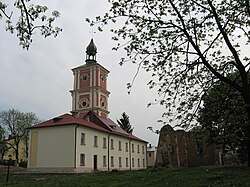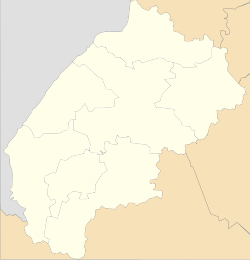Belz(Ukrainian:Белз,IPA:[bɛlz];Polish:Bełz;Yiddish:בעלז) is a small city inLviv Oblast,westernUkraine,located near theborder with Polandbetween the Solokiya River (a tributary of theBug River) and the Richytsia stream. Belz hosts the administration ofBelz urban hromada,one of thehromadasof Ukraine.[1]Its population is approximately2,191 (2022 estimate).[2]
Belz
Белз | |
|---|---|
 City Hall | |
| Coordinates:50°23′N24°01′E/ 50.38°N 24.02°E | |
| Country | Ukraine |
| Oblast | Lviv Oblast |
| Raion | Sheptytskyi Raion |
| Hromada | Belz urban hromada |
| Government | |
| • Mayor | Volodymyr Mukha |
| Area | |
• Total | 5.85 km2(2.26 sq mi) |
| Elevation | 200 m (700 ft) |
| Population (2022) | |
• Total | 2,191 |
| • Density | 370/km2(970/sq mi) |
| Zip Code | 80065 |
| Area code | +380 3257 |
 | |
Origin of name
editThere are a few theories as to the origin of the name:
- Celtic–belz(water) orpelz(stream),
- German–Pelz/Belz(fur, furry)
- Old Slavicand theBoyko language– «белз» or «бевз» (muddy place),
- Old East Slavic– «бълизь» (white place, a glade in the midst of dark woods).
The name occurs only in two other places, the first being a Celtic area in antiquity, and the second one being derived from its Romanian name:
History
editDuchy of Poland970 - 981
Kievan Rus981-1018
Duchy of Poland1018-1025
Kingdom of Poland1025-1031
Kievan Rus1031-1170
Duchy of Belz1170-1234
Principality of Galicia–Volhynia1234-1340
Grand Duchy of Lithuania1340-1366
Kingdom of Poland1366-1377
Kingdom of Hungary1378-1387
Kingdom of Poland1387-1569
Polish–Lithuanian Commonwealth1569-1772
Habsburg monarchy1772-1804
Austrian Empire1804-1867
Austria-Hungary1867-1918
West Ukrainian People's Republic1918-1919
Second Polish Republic1919-1939
Nazi Germany1939-1944
Polish People's Republic1944-1951
Soviet Union1951-1991
Ukraine1991-present
Early history
editBelz is situated in a fertile plain which tribes ofIndo-Europeanorigin settled in ancient times: CelticLugii,[3][4]next (2nd-5th century) GermanicGoths,[5][6]slavizedSarmatians(White Croats),[7]and at last SlavicDulebes[8](laterBuzhans), who eventually become part of theKievan Rus'in 907, when Dulebs took part inOleg'smilitary campaignagainstCzargrad(Constantinople).[9]Mainly рolish historiography located here alsoLendianstribe[10]whо also paid tribute to Kievan Rus'.[11]
The town has existed at least since the 10th century as one of theCherven Cities[12]which were underPolishrule in the 970s.[13]In 981 Belz was incorporated intoKievan Rus'.[14]In 1170, the town became the seat of aduchy.In 1234 it was incorporated into theDuchy of Galicia–Volhynia,which would control Belz until 1340 when it came underLithuanianrule.
Belz was under Polish rule from 1366 to 1772, first as a fief, and since 1462 as the capital of avoivodeship.On October 5, 1377, the town was granted rights under theMagdeburg lawbyWładysław Opolczyk,the governor ofRed Ruthenia.A charter dated November 10, 1509 once again granted Belz privileges under the Magdeburg rights.[15]
In 1772, Belz was incorporated into theHabsburg Empire(laterAustrian EmpireandAustro-Hungarian Empire) where it was a part of theKingdom of Galicia and Lodomeria.
Belz received a railway connection in 1884 with the opening of the railway line Jarosław–Kowel.[16]
Modern history
editWith the collapse of Austria-Hungary following World War I in November 1918, Belz was included in theWestern Ukrainian People's Republic.It came under Polish control in 1919 during thePolish-Ukrainian War.In April 1920, the Second Polish Republic, represented by Józef Piłsudski, and the Ukrainian People's Republic, represented by Symon Petlura signed theTreaty of Warsaw,in which they agreed that the Polish-Ukrainian border in Western Ukraine would follow theZbruch River.This left Belz, along with the rest ofEastern Galiciain the Polish Republic.[17]
From 1919 to 1939 Belz was annexed to theLviv Voivodeship,Second Polish Republic.
From 1939 to 1944 Belz was occupied by Germany as a part of theGeneral Government.Belz is situated on left, north waterside of the Solokiya river (affluent of the Bug river), which was the German-Soviet border in 1939–1941. During the war, the delegation of the Hrubeshiv Ukrainian Relief Committee operated in the city.[18]
After the war Belz reverted to Poland (where it was again within theLublin Voivodeship) until 1951 when, after a border readjustment, it passed to the Soviet Union (Ukrainian Soviet Socialist Republic). (See:1951 Polish–Soviet territorial exchange) Since 1991 it has been part of independent Ukraine.
Until 18 July 2020, Belz belonged toSokal Raion.The raion was abolished in July 2020 as part of the administrative reform of Ukraine, which reduced the number of raions of Lviv Oblast to seven. The area of Sokal Raion was merged into Chervonohrad Raion (modern Sheptytskyi Raion).[19][20]
Jewish history
editTheAshkenazi Jewishcommunity in Belz was established circa 14th century. In 1665, the Jews in Belz received equal rights and duties.[21]The town became home to aHasidicdynasty in the early 19th century.[22][23]
TheRabbiof Belz,Shalom Rokeach(1779–1855), also known as theSar Shalom,joined theHasidicmovement by studying with theMaggidof Lutzk,[24]and established the community and become the firstBelzerRebbe,thereby establishing theBelz Hasidic dynasty. When Rebbe Shalom died in 1855, his youngest son, Rebbe Yehoshua Rokeach (1855–1894), became the next Rebbe. Belzer Hasidism grew in size during the tenure of Rebbe Yehoshua's son and successor, Rebbe Yissachar Dov Rokeach (third Belzer Rebbe)(1894–1926). Rebbe Yissachar Dov's son and successor, Rebbe Aharon Rokeach (1880 to 1957), escaped from Nazi-occupied Europe to Israel in 1944, re-establishing the Hasidut first in Tel Aviv and then in Jerusalem. For recent history seeBelz (Hasidic dynasty) § Belz today.
At the beginning of World War I, Belz had 6100 inhabitants, including 3600 Jews, 1600 Ukrainians, and 900 Poles.[25]During the German and Soviet invasion of Poland (September 1939), most of the Jews of Belz fled to the Soviet Union in Autumn 1939 (theGerman–Soviet Treaty of Friendship, Cooperation and Demarcation). However, by May 1942, there were over 1,540 local Jewish residents and refugees in Belz. On June 2, 1942, 1,000 Jews were deported toHrubieszówand from there toSobibor extermination camp.Another 504 were brought toHrubieszówin September of that year, after they were no longer needed to work on the farms in the area.[26]
Cultural trivia
editThe Yiddish song“Beltz, Mayn Shtetele”is a moving evocation of a happy childhood spent in ashtetl.Originally this song was composed for a town which bears a similar-sounding name inYiddish(belts), calledBălțiinMoldovan/Romanian,and is located inBessarabia[27](presently theMoldovaRepublic). Later interpretations may have hadBelzin mind, though.[citation needed]The song has special significance inHolocausthistory, as a 16-year-old playing the song was overheard by anSSguard atAuschwitzextermination camp, who then forced the child to play it repeatedly to ease the moods of Jews being herded into thegas chambers.[citation needed]
Belz is also a very important place forUkrainian CatholicsandPolish Catholicsas a place where theBlack Madonna of Częstochowa(this icon was believed to have been painted by St.Luke the Evangelist) had resided for several centuries until 1382, whenWładysław Opolczyk,duke ofOpole,took the icon home to his principality after ending his service as the Royal emissary forHalychynaforLouis I of Hungary.[28]
Literature –Belles-lettres:a poemMaria: A Tale of the Ukrainewritten byAntoni Malczewski,and a novelStarościna Bełska: opowiadanie historyczne 1770–1774byJózef Ignacy Kraszewski.
Notable people
edit- Vsevolod Mstislavich of Volhynia,prince of Belz (1170–1196)
- Vasilko Romanovich,prince of Belz (1207–1211)
- Alexander Vsevolodovich,prince of Belz (1212–1234)
- Daniel of Galicia,prince of Belz (1234–1245)
- Lev I of Galicia,prince of Belz (1245–1264)
- Yuri I of Galicia,prince of Belz (1264–1301)
- Andrew of Galicia,prince of Belz (1308–1323)
- Boleslaw-Yuri II of Galicia,Polish–Lithuanian-Ruthenian prince of Belz (1323–1340)
- Yuri Narimuntovich(Jurgis Narimantaitis), Lithuanian, prince of Belz (1340–1377)
- Władysław Opolczyk,Silesian duke, Hungarian governor (1377–1378)
- Siemowit IV, Duke of Masovia,prince of Belz (1388–1426)
- Jaśko Mazowita,prefect of Belz (14th–15th centuries)
- Casimir II of Belz,prince of Belz (1434–1442)
- Jan Kamieniecki(1463–1513), starost of Belz
- Mikołaj Sieniawski(c. 1489–1569), voivode of Belz
- Jan Firlej(c. 1521–1574), voivode of Belz
- Jan Zamoyski(1542–1605), starost of Belz
- Yoel Sirkis(1561–1640), the Bach, later rabbi ofKrakow,one of theAcharonim
- Rafał Leszczyński(1579–1636), voivode of Belz
- Jakub Sobieski(1580–1646), voivode of Belz
- Dymitr Jerzy Wiśniowiecki(1631–1682), voivode of Belz
- Marcin Zamoyski(c.1637–1689), starost of Belz
- Stefan Aleksander Potocki,voivode of Belz
- Adam Mikołaj Sieniawski(1666–1726), voivode of Belz
- Stanisław Mateusz Rzewuski(1642–1728), voivode of Belz
- Stanisław Szczęsny Potocki(1753–1805), starost of Belz
- Sholom Rokeach(1779–1855), the firstRebbeof Belz
- Malka Rokeach(1780–1853), the firstrebbetzinof Belz
- Yehoshua Rokeach(1825–1894), the secondRebbeof Belz
- Yissachar Dov Rokeach(1854–1926), the thirdRebbeof Belz
- Aharon Rokeach(1877–1957), the fourthRebbeof Belz
- Mordechai Rokeach(1902–1949), rabbi ofBilgoraj,son of thethird Belzer Rebbe,half-brother andspokesmanfor thefourth Rebbeand father of thefifth Rebbe
See also
editReferences
edit- ^"Белзькая городская громада"(in Russian). Портал об'єднаних громад України.
- ^Чисельність наявного населення України на 1 січня 2022[Number of Present Population of Ukraine, as of January 1, 2022](PDF)(in Ukrainian and English). Kyiv:State Statistics Service of Ukraine.Archived(PDF)from the original on 4 July 2022.
- ^Gaius Cornelius Tacitus,De Origine et situ Germanorum
- ^Alexander Falileyev, Celto-Slavica. University of Ulster, 2004
- ^"Hrubieszowskie w dobie panowania Gotów".Archived fromthe originalon 2009-09-24.Retrieved2008-10-28.
- ^Andrzej Kokowski,Archeologia Gotów. Goci w Kotlinie Hrubieszowskiej,Lublin 1999
- ^Kazimierz Godłowski,Z badań nad rozprzestrzenieniem się Słowian w V-VII w. n.e.,Kraków 1979
- ^Paul M. Barford (January 2001).The Early Slavs: Culture and Society in Early Medieval Eastern Europe.Cornell University Press. p. 104.ISBN978-0-8014-3977-3.
- ^Carl Waldman; Catherine Mason (2006).Encyclopedia of European Peoples.Infobase Publishing. p. 878.ISBN978-1-4381-2918-1.
- ^Magdalena Mączyńska,Wędrówki Ludów.Kraków 1996
- ^Constantino VII (Emperador de Bizancio), Constantine VII Porphyrogenitus (Emperor of the East), Gyula Moravcsik. De Administrando Imperio -P.57
- ^"Wyborcza.pl".
- ^Under 981, the Primary Chronicle reports on Volodymyr's campaign against the Poles, which resulted in the capture of "their towns". In: S. Plokhy. "The origins of the Slavic nations: premodern identities in Russia, Ukraine, Belarus". Cambridge University Press, 2006. p. 57.
- ^Artur Pawłowski,Roztocze,Oficyna Wydawnicza "Rewasz", Warszawa 2009.ISBN978-83-89188-87-8
- ^Yehorova, Iryna."Belz is 1,000 years old".
- ^"ÖNB-ALEX - Reichsgesetzblatt 1849-1918".Österreichische Nationalbibliothek.Retrieved29 February2020.
- ^Richard K Debo,Survival and Consolidation: The Foreign Policy of Soviet Russia, 1918–1921,pp. 210-211,McGill-Queen's Press, 1992,ISBN0-7735-0828-7.
- ^"Diasporiana Електронна бібліотека | Кубійович В. Українці в Ґенеральній Губернії 1939-1941".diasporiana.org.ua.Retrieved2023-05-14.
- ^"Про утворення та ліквідацію районів. Постанова Верховної Ради України № 807-ІХ".Голос України(in Ukrainian). 2020-07-18.Retrieved2020-10-03.
- ^"Нові райони: карти + склад"(in Ukrainian). Міністерство розвитку громад та територій України.
- ^Dr Fryderyk Papée,Zabytki przeszłości miasta Bełza.Lwów 1884
- ^Rabinowicz, Rabbi Tsvi (1989)."Chassidic Rebbes: From the Baal Shem Tov to Modern Times".Targum Press.
- ^Yodlov, Yitshak Shlomo."Sefer Yikhus Belz (The Lineage Book of the Grand Rabbis of Belz)".
- ^Preface to the Divras Shlomo signed by the Belzer Rebbe, 1997
- ^Dr Mieczysław Orłowicz.Ilustrowany Przewodnik po Galicyi.Lwów 1919.
- ^Spector, Shmuel and Wigoder, Geoffrey,The Encyclopedia of Jewish Life Before and During the Holocaust,p. 105. NY:NYU Press 2001.
- ^Ami Living(87): 45. September 12, 2012.
{{cite journal}}:Missing or empty|title=(help) - ^The Black MadonnaArchivedJanuary 26, 2008, at theWayback Machine
Further reading
edit- Weiner, Miriam; Ukrainian State Archives (in cooperation with); Moldovan National Archives (in cooperation with) (1999). "Chapter 11: Town Clips: Belz".Jewish Roots in Ukraine and Moldova: Pages from the Past and Archival Inventories(PDF).Secaucus, NJ: Miriam Weiner Routes to Roots Foundation. p. 402.ISBN978-0-96-565081-6.OCLC607423469.



